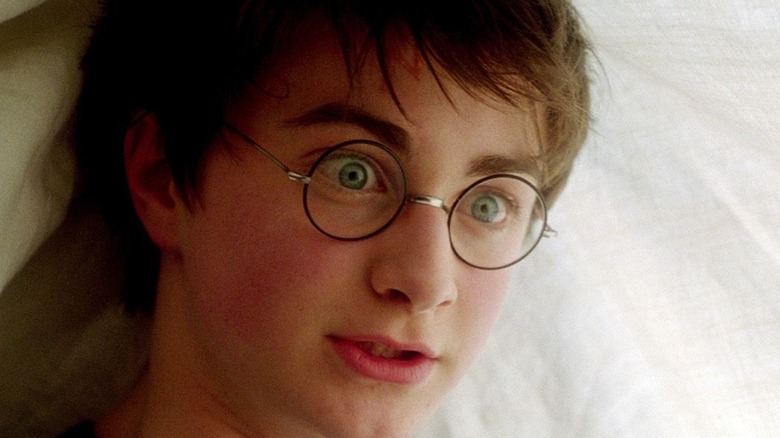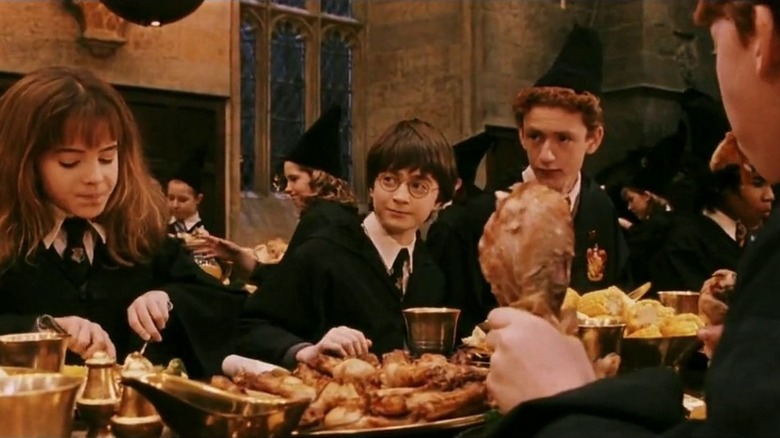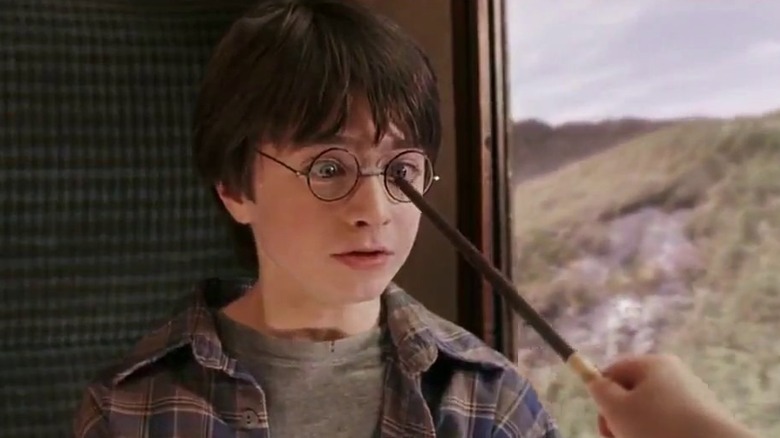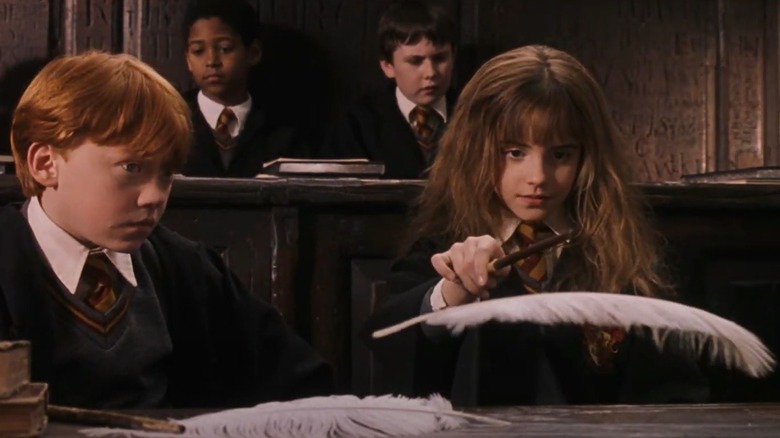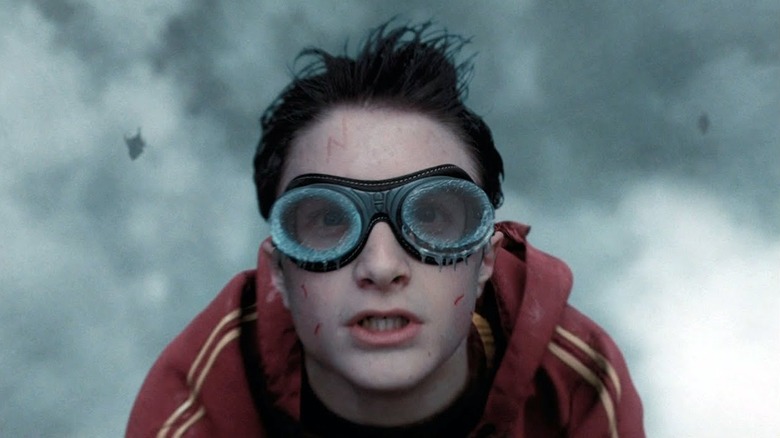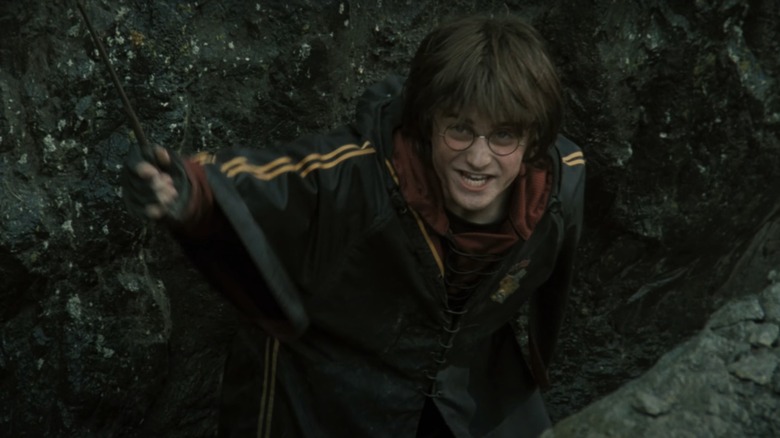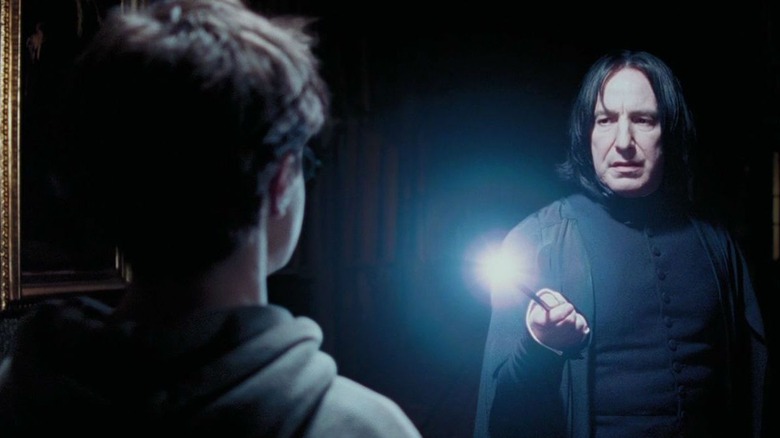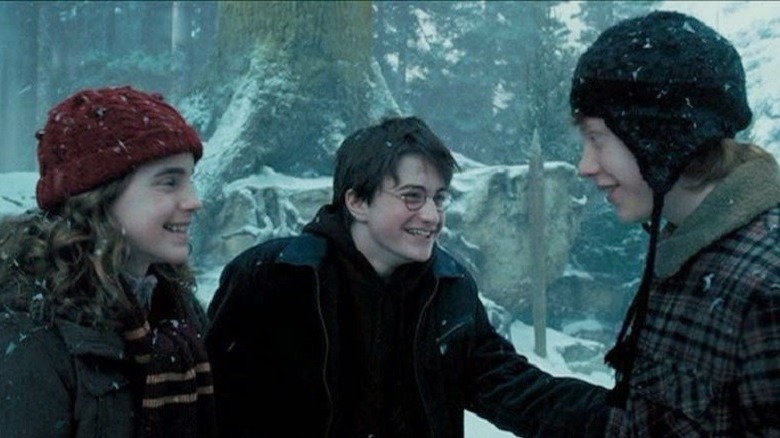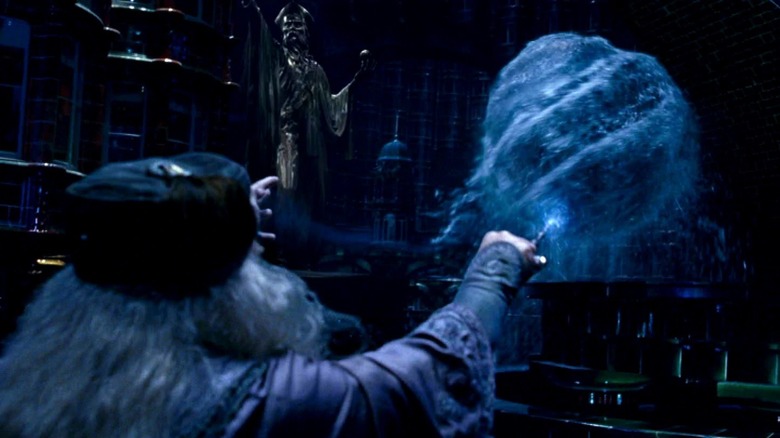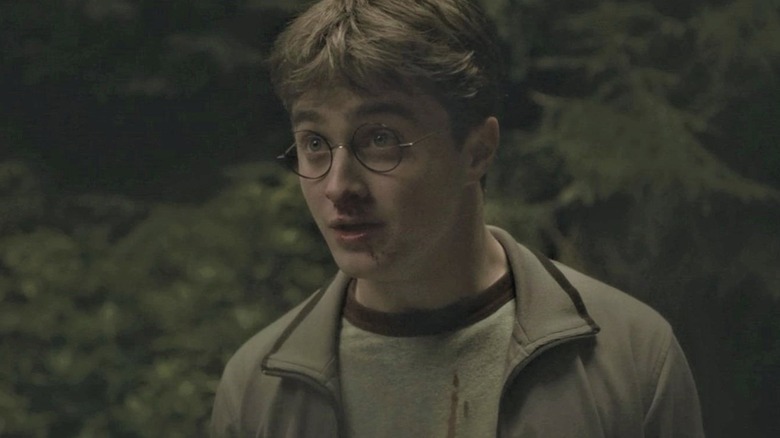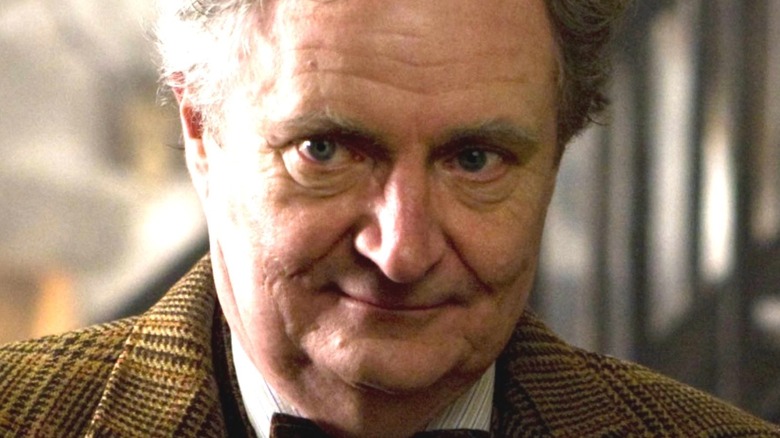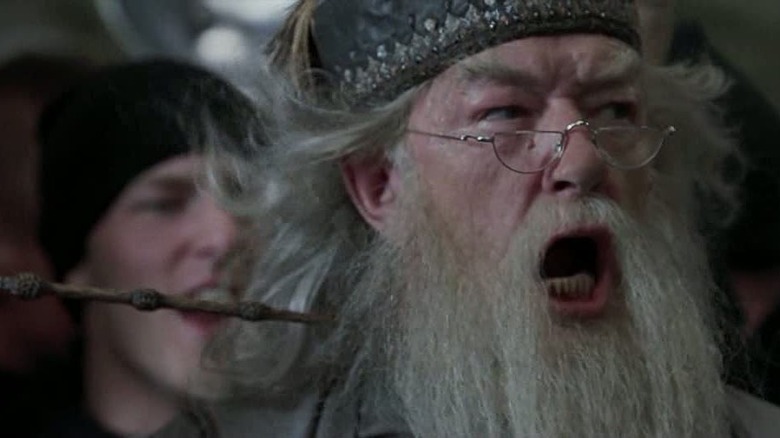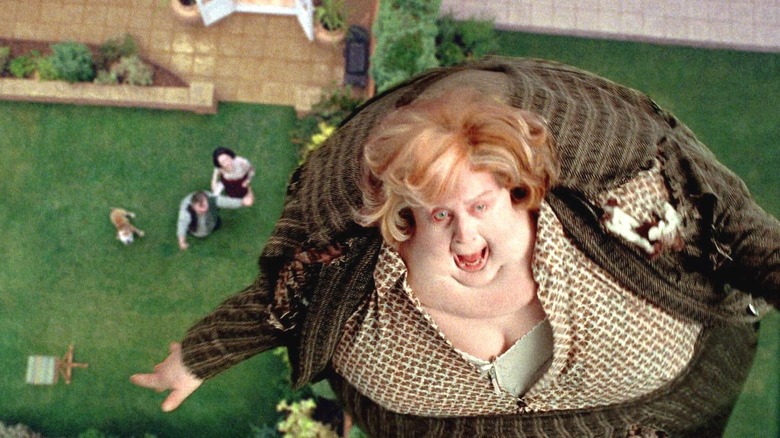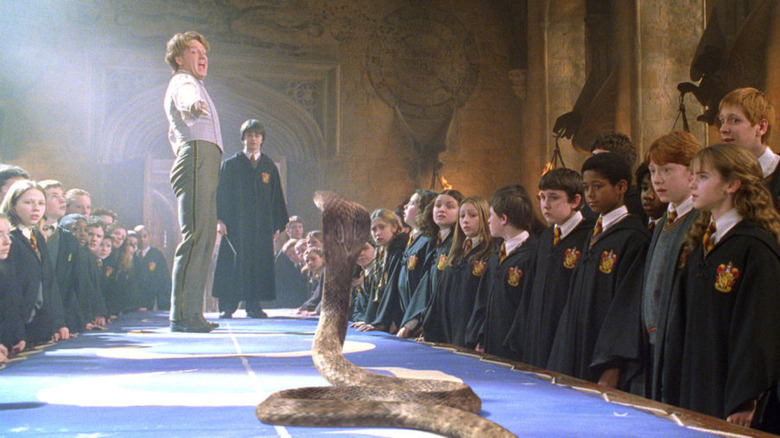The Harry Potter Spell That Would Be The Most Useful In Everyday Life
J.K. Rowling invented hundreds of different spells as she penned the "Harry Potter" series, breaking them down into charms, hexes, jinxes, and curses. Many of these spells and their accompanying incantations have become part of the pop culture lexicon.
Collectively known as the Unforgivable Curses, the Imperius Curse (Imperio), the Cruciatus Curse (Crucio), and the Killing Curse (Avada Kedavra) are among the most well known, favored by Lord Voldemort (Ralph Fiennes) and his followers. All three spells are pretty useful if you're a Death Eater, but outside of those circles, usage is rare. The same can be said of the equally famous Patronus Charm — which Harry Potter (Daniel Radcliffe) used to fend off the Dementors of Azkaban — while it looks pretty, it is essentially useless to your regular, law-abiding wand user.
If Rowling's Wizarding World was actually real, the spells that would be used most regularly are the ones that make everyday life a little — or, in most cases, a lot — easier. After perusing the author's catalog of spells, here is a list of the most useful incantations.
Scourgify makes cleaning up a thing of the past
Also known as the Scouring Charm, Scourgify is a cleaning spell that does exactly what it says on the parchment. The user needs only to point their wand at a dirty object, utter the incantation (or don't, if you're skilled enough to perform the spell non-verbally), and everything will be spiffy in an instant. For those that spend a lot of time in the kitchen, there's the more-specific washing up spell used by Molly Weasley (Julie Walters) during Harry Potter's first visit to The Burrow in "Harry Potter and the Chamber of Secrets," but Scourgify will cover all your cleaning needs, from greasy pots and pans to that wine stain on the rug.
There are also a couple of bonus uses for Scourgify, though one of them would likely land you in trouble with child protective services if you did it in real life. In the Wizarding World, parents have been known to use the Scouring Charm to punish potty-mouthed kids — using this spell on a person will cause their mouth to fill up with soap. Scourgify is also useful for removing stubborn dirt and debris (or dried frog guts, in the case of Neville Longbottom) from underneath the fingernails.
Reparo is the clumsy person's best friend
If you're a Harry Potter fan and you wear glasses, chances are you're already aware of Oculus Reparo, a variation on one of the most useful spells featured in the franchise. Also known as the Mending Charm, Reparo allows the user to restore just about anything to its original state. Dropped your favorite coffee mug? Fixed in an instant. Cracked your TV moving home? Good as new. Blown your bedroom door off messing around with potions? No problem. In fact, you could trash your entire house from top to bottom and put it all right again in a jiffy using this incredible spell.
When Hogwarts headmaster Albus Dumbledore (Michael Gambon) attempts to recruit Horace Slughorn (Jim Broadbent) for a teaching post at the start of "Harry Potter and the Half-Blood Prince," he finds him hiding out in a wrecked muggle home. In the book, the on-the-run Slughorn (who caused the damage to give the impression of an abduction) helps put things back in order via Reparo, but in the movie, Dumbledore does it solo. The Mending Charm fixes everything in the room: the mirror, the grand piano, even the chandelier (Slughorn clearly picked the home of wealthy muggles to hide out in), leaving Harry in awe of the spell's power.
Wingardium Leviosa would be great for moving home
Believe it or not, only four actual spells are used in "Harry Potter and the Philosopher's Stone," the first installment in the series. Most of them wouldn't be of much practical use in everyday life, but one would make the nightmare that is moving home a relatively stress-free process. We're introduced to Wingardium Leviosa, a.k.a the Levitation Charm, during Professor Flitwick's (Warwick Davis) class. Hermione Granger (Emma Watson) perfects it with typical ease, much to the chagrin of future husband Ron Weasley (Rupert Grint). The incident nearly ruined their relationship before it began: Hermione overhears Ron mocking her for correcting his pronunciation.
The students are asked to perform the Levitation Charm on feathers in class, but Wingardium Leviosa could of course be used to lift much heavier items, from sofas and beds to kitchen goods and even vehicles — there would be no need for a jack in the event of a flat tire. It's a spell that is rarely used in battle, but Ron put it to good use when he saved Hermione from the mountain troll. Discovering his classmate under attack in the bathroom, the first year uses the Levitation Charm on the troll's club and manages to knock it out, redeeming himself.
Impervius would be a dream come true for people with glasses
Another spell that would be super useful in the day-to-day lives of all the glasses wearers out there, the Impervius Charm makes the target object repel all forms of moisture.
Hermione Granger used it on Harry Potter's spectacles when he was struggling to see during a rainy Quidditch match, and this tactic was later adopted by the rest of the Gryffindor team during one stormy practice session. Incidentally, this wasn't the only time Hermione influenced the Quidditch with her magic — she secured Ron Weasley's place on the Gryffindor team when she used the Confundus Charm on his obnoxious rival Cormac McLaggen (Freddie Stroma) during tryouts.
Hermione also used Impervius when she, Harry, and Ron broke into Gringotts during the film "Harry Potter and the Deathly Hallows Part 2," though bank robbers would be unlikely to use this spell in real life. The steamy spectacle struggle has become even more real in the age of mask wearing, and countless people would snap your wand off for the chance to use Impervius on their glasses. Of course, the spell works on more than just specs — use Impervius on your entire outfit (not forgetting your hat) and say bye-bye to umbrellas.
Accio would mean no more moving for the remote
One of the most famous spells from the Wizarding World and definitely one of the most useful, Accio lets the caster bring any object right to their fingertips without having to leave their armchair. Also known as the Summoning Charm, Harry Potter famously utilized it twice during the Triwizard Tournament — first to fetch his broom in the dragon task, and again after the death of Robert Pattinson's Cedric Diggory by summoning the Triwizard Cup (which at this point he had realized was a port key) and escaping from the revived Lord Voldemort with his fallen schoolmate's body.
Of course, Accio isn't reserved for dramatic and/or tragic situations. In real, everyday life, it would most likely be used to find mundane items that have been misplaced. There would be no more rummaging down the back of the sofa for the remote control, and those missing car keys would be back in your possession with a flick of the wrist. This spell is also a must-learn for parents, as Molly Weasley proved when she used it to relieve twin sons Fred and George (James and Oliver Phelps) of the magical treats they tried to smuggle into the Quidditch World Cup.
Lumos would render your torch app redundant
As someone who made a habit of wandering around Hogwarts at night, Harry Potter was well acquainted with the Wand-Lighting Charm, better known as Lumos.
This widely-used spell made its debut in "Harry Potter and the Chamber of Secrets," and would appear in every installment that came after it. Harry taught himself the much more powerful variant, Lumos Maxima, while still living with the Dursleys, around two years before he was due to be taught it at school. Hermione Granger used another modified version of the spell towards the end of "Harry Potter and the Philosopher's Stone" when the trio came up against some Devil's Snare — which, as she rightly remembered, is "deadly fun but will sulk in the sun."
Killing giant weeds is one way you could use Lumos and its variants in real life, but in terms of everyday use, this powerful spell would quickly replace your torch — or the torch app on your phone, at least. Remember, wands don't run out of battery. Of course, you would need to learn the counter spell Nox, a.k.a the Wand-Extinguishing Charm, too. Nobody wants the tip of their wand to be illuminated indefinitely, after all.
The Cheering Charm is the feel-good spell the world needs
Another spell that does exactly as described, the Cheering Charm would be the ideal tonic for our trying times.
Invented by a wizard named Felix Summerbee in the 15th Century, it's literally a feel-good spell, filling the intended target with a sense of joy. Like all good things, however, too much of it can have consequences, as Ron Weasley found out firsthand during his third year Charms examination.
When a witch or wizard overcooks a Cheering Charm, they run the risk of sending the person they are trying to cheer up into fits of hysterics. In this instance, it wasn't Ron who overshot his spell, it was his partner and bestie, Harry Potter. The two were paired up during the exam, and when Harry was asked to perform the Cheering Charm on Ron, he hit him with it so hard that he had to be isolated from the class while he calmed down. Nevertheless, it's still far from the worst thing Harry Potter did during his time at Hogwarts.
Augmenti could solve a lot of the world's problems
Students at Hogwarts add the Water-Making Spell to their arsenals in year six, in preparation for their all-important N.E.W.T. exams the following year. Of course, by the time Harry Potter reaches this stage of his school life, he's got more important things on his mind. Lord Voldemort is back and Harry's too busy thinking about his plans to worry about exams, though he was able to pick up the spell (also known as the Aguamenti Charm) regardless. For the sake of Robbie Coltrane's Hagrid, it's a good thing he did.
Harry used Aguamenti when Hagrid's hut was set on fire by Death Eaters, and he also turned to this spell during the Battle of Hogwarts, shooting water at the Fiendfyre cast by Vincent Crabbe (fellow Slytherin goon Gregory Goyle releases the cursed fire in "Harry Potter and the Deathly Hallows Part 2"). It turns out Aguamenti doesn't work against Fiendfyre, but one problem it does solve is thirst — the water produced by the Water-Making Spell is clean and totally drinkable. If any single Harry Potter spell could change the world for the better, it might be this one.
Episkey would revolutionize first aid
Anyone who has ever suffered a broken nose will tell you just how appealing a magic word that puts it right back into place sounds. That word is Episkey, the incantation of a charm that heals minor injuries.
From busted lips to broken toes and, of course, noses, this spell would eliminate many trips to the emergency room, a place no muggle wants to be. It's used to fix Harry's nose after Draco Malfoy (Tom Felton) breaks it on the Hogwarts Express towards the start of "Harry Potter and the Half-Blood Prince," though the book differs slightly from what we saw on the big screen.
In J.K. Rowling's penultimate Potter novel, Draco hits Harry with a Full Body-Bind Curse after he realizes he's been spying on him using his invisibility cloak. He stomps on Harry's face, dedicates the blow to his Death Eater dad, and covers him with the cloak, assuming he won't be discovered until the train gets back to London. Luckily, Harry is happened upon by the auror Nymphadora Tonks (Natalia Tena), who uses Episkey to re-set his busted nose. In the movie version of "Harry Potter and the Half-Blood Prince," it's Harry's fellow student Luna Lovegood (Evanna Lynch) that finds and fixes him up.
Anapneo would be a real life saver
Albus Dumbledore went to great lengths to bring Horace Slughorn back to Hogwarts for a second spell as a professor, such is his pedigree as a wizard. The potions master takes great pride in the fact that he taught several students who went on to achieve great things, Harry Potter's mother among them. He decides to reopen the so-called Slug Club for admission upon his return to the school, inviting a handful of promising youngsters to a dinner party where he can assess them in person.
Harry is of course on the guest list (Dumbledore dangled The Boy Who Lived as bait during negotiations with Slughorn, knowing he wouldn't be able to resist adding him to the Slug Club), and so is Hermione Granger. Also in attendance is a Ravenclaw student named Marcus Belby, whose uncle invented the Wolfsbane Potion. He seems more interested in the food than the conversation, however. Belby shovels so much down that he ends up choking, though that's nothing to panic about in a world where Anapneo exists — this spell instantly clears the airway of the target. It's the Heimlich maneuver without the hard work.
The Amplifying Charm would make you impossible to ignore
If you grew up in a big family, you'll already know just how valuable the Amplifying Charm would be in everyday life.
It was a favorite of Albus Dumbledore during his time at the helm of Hogwarts, particularly during the Triwizard Tournament, where he utilized the spell in his unofficial role as the competition's emcee. Ludovic Bagman, Head of the Department of Magical Games and Sports, also used it when he opened the 422nd Quidditch World Cup in "Harry Potter and the Goblet of Fire," putting his wand to his neck and addressing the crowds (Minister for Magic Cornelius Fudge took his place in the film version).
The Amplifying Charm (which has the incantation Soronus, in case you feel like trying it) would eliminate the need for microphones and megaphones, and it would no doubt help a few parents out, too. This spell can also be used on inanimate objects like the TV or, in Molly Weasley's case, the radio. The mother of seven used Soronus to crank up the volume on her wireless when the nattering of her French daughter-in-law, Fleur Delacour, began to grind on her in "Harry Potter and the Half-Blood Prince."
The sound of Silencio
Working on animals as well as humans, the Silencing Charm is guaranteed quiet time.
It's perfectly okay to use on kids (Professor McGonagall cast Silencio on a corridor full of panicky students when Justin Finch-Fletchley's petrified body was discovered in "Harry Potter and the Chamber of Secrets"), though it does take a practiced hand. Hogwarts students are taught this spell during their fifth year, and it's known to be a particularly tricky one to master. Get it wrong, and it can have the opposite effect — the target begins to swell and screech.
Hermione Granger found this out the hard way in Professor Flitwick's Charms class. The students were given frogs and ravens to practice the Silencing Charm on, and, in a very non-Hermione moment, the brightest witch of her age messes up, turning Harry's frog into a balloon animal. Silencio is thought to be the spell that Harry accidentally used non-verbally on his menace of an aunt, Marjorie Dursley, who started to swell and float after unfairly and unwisely berating him in "Harry Potter and the Prisoner of Azkaban."
Vipera Evanesca would mean never being scared of snakes again
Another must-know spell, the super handy Evanesco is used to make absolutely anything vanish. If you happen to suffer from a fear of slithering things, however, there's the more specific Vipera Evanesca, a.k.a the Snake-Vanishing Spell. We were introduced to this spell when Harry Potter and dozens of other students attended the Duelling Club in "Harry Potter and the Chamber of Secrets," overseen by Professor Snape (Alan Rickman) and Professor Lockhart (Kenneth Branagh). After showing his useless new colleague up in front of the kids, Snape decides to pit Harry against Draco Malfoy.
Draco conjures a snake during their duel, and after Lockhart proves incapable of disposing of it, Snape steps in and uses Vipera Evanesca (which literally means "viper disappear"). It was later used by Hogwarts headmaster Albus Dumbledore when he fought Voldemort at the Ministry of Magic. The Dark Lord conjured a fire snake during their memorable duel, forcing Dumbledore to act quickly. You're not likely to come across many fire snakes in real life, granted, but Vipera Evanesca would be a most welcome addition to any hiker's spellbook.
Expelliarmus would make muggers think twice
It was the first spell that we actually witnessed Harry Potter execute in the books (he used it on Draco Malfoy when the Slytherin troublemaker snatched Tom Riddle's diary in "Harry Potter and the Chamber of Secrets"), and Expelliarmus went on to become his "signature move," as Remus Lupin (David Thewlis) put it. Otherwise known as the Disarming Charm, it helped Harry out on numerous occasions. He used it on sham teacher Gilderoy Lockhart; tragic hero Severus Snape; slimy traitor Peter Pettigrew; Draco's dad Lucius Malfoy; and, of course, Lord Voldemort.
When Harry and Voldemort engage in their final duel, the latter goes straight for his bread and butter: Avada Kedavra, the Killing Curse. Harry being Harry, he opts for Expelliarmus, and it turns out to be a wise move. Voldemort's Killing Curse backfires and he's finally gone for good.
Harry's persistent use of the spell paid off, and it's hard to not wish it existed in real life. As Harry demonstrated by whipping Tom Riddle's diary from Draco's greasy grasp, Expelliarmus works on more than just wands. Guns, knives, nunchucks — whatever a mugger might come at you with, they're going to find themselves disarmed in an instant.
